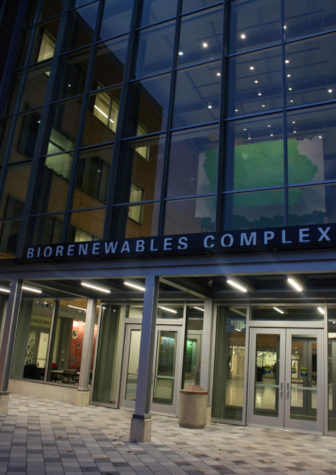Think globally by eating locally
September 7, 2012
According to the dictionary, a “locavore” is a person interested in eating food that is locally produced. The goal of a locavore is to eat local food, but the definition of local can vary from person to person. For some, local means food that has been grown and harvested within 100 miles from their home.
Sustainably speaking, eating locally also means food that is grown with traditional farming practices, using no man-made pesticides, fungicides or hormones. It also means using meat from animals that have been raised humanely and pastured. Interested in this concept, I decided to live as a locavore for a week. I began my experience by researching facts about local and organic farming practices.
Fresh, local food is always healthier. Purchasing foods produced closer to home ensures that it is permitted to mature and ripen on the vine as long as possible, which means greater nutrition. Buying locally-grown organic foods also decreases dependence on petroleum, a nonrenewable energy source, as organic production systems do not rely upon the input of petroleum derived fertilizers and pesticides.
Sustainable farmers produce food using techniques such as crop rotation, conservation tillage, animals raised on pasture and natural fertilization. Because industrial farms are owned by large corporations, they typically have incentives to maximize profit with little regard for the communities in which their farms and processing plants are located. Researchers from the department of economics at the University of Essex put the annual cost of environmental damage caused by industrial farming in the United States at $34.7 billion.
With all this in mind, I began my week at the Ames Main Street Farmer’s Market. The variety of food I found there was wonderful and unusual. Organic farmers who sell locally are not limited to the few varieties that are bred for long distance shipping, high yields and a longer shelf life. Often they raise and sell varieties you will never find on supermarket shelves. Many local farms were represented at the market.
From TableTop Farm, established in Nevada, Iowa, in 2011, I was able to purchase cherry tomatoes, summer squash and garlic. I learned they use physical barriers (row covers preventing contact), mulch, pro-biotics and hand weeding as some of their practices. They also created a native prairie habitat to boost pollinating insects, as well as to support plants and wildlife. Their products can be purchased at Wheatsfield and are used at The Café, a restaurant in North Ames.
According to the Leopold Center for Sustainable Agriculture, a typical carrot has to travel 1,838 miles to reach your dinner table. I bought certified organic carrots, basil, cantaloupe and green beans from Prairie Bloom Farm from right here in Ames.
In search of locally grown fruits, I visited the Berry Patch Farm in Nevada, about 14 miles from Ames. The Berry Patch farm is an organic, pick-your-own fruit farm and has been family-owned since 1974. I picked my own apples, raspberries and blackberries.
Sustainable meat can also be purchased locally and is not hard to find. The Cory Family Farm from northeast Polk County raises all-natural, antibiotic- and hormone-free beef and lamb. The animals are locally born, raised and processed at the state inspected Mingo locker. Little Stone House Farm, in Colo, raises low-stress pigs outdoors with no antibiotics. Heavy Horses Farm in Boone has free-range chickens and ducks and sells organic eggs.
Local, sustainable meat actually contributes to environmental health. The animals are bred and slaughtered in ways that cause minimal environmental harm. Their eating habits and manure-production form essential parts of a healthy ecosystem. Slaughtering techniques used by industrial farms lead to the release of greenhouse gases, contributing to global climate change. Meat plants produce harmful air and water pollution, destroying ecosystems and polluting drinking water. Because these plants tend to be large and centralized, the meat they produce must be transported large distances, using fossil fuels and causing further air pollution. The Environmental Protection Agency reports the waste generated by animal agriculture has polluted over 35,000 miles of river in 22 states.
One major downside to shopping locally and organically is cost. It has been reported that shoppers who consistently shop organic spend nearly 20 percent more on groceries. However, there are ways to eat environmentally-friendly on a budget. Farmer’s markets, for example, are great places to buy seasonal and bulk produce.
Taking cost and season into consideration, it’s not always possible to buy from farmer’s markets or purchase all organic products. When shopping, remember the “Dirty Dozen,” foods that typically contain higher-than-average levels of pesticides and herbicides. These are the foods that should take priority when deciding the importance of spending the extra money.
• Apples
• Cherries
• Grapes
• Peaches
• Nectarines
• Pears
• Lettuce
• Strawberries
• Bell peppers
• Celery
• Potatoes
• Spinach
By supporting small, sustainable farms, you can help reduce the impact of industrial farming and promote the use of environmentally friendly farming methods. It’s a healthy way to eat, and it helps your food dollars stay in your community. Eating food grown within 100 to a few hundred miles of your home reduces your food miles (the miles and energy it takes to ship it to your plate), which is very earth friendly. Buying organic and sustainably, you can also reduce your consumption of food contaminated by chemical fertilizers, hormones, antibiotics, artificial flavors, texturizers and preservatives, which would not only improve your own health, but the health of your local community and environment.









